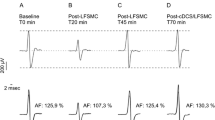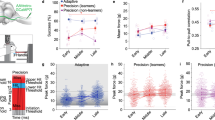Abstract
The excitability of cortical neurons in the motor cortex is determined by their membrane potential and by the level of intracortical inhibition. The excitability of the motor cortex as a whole is a function of single cell excitability, synaptic strength, and the balance between excitatory cells and inhibitory cells. It is now established that a sustained period of somatosensory stimulation increases the excitability of motor cortex areas controlling muscles in those body parts that received the stimulation prior to excitability testing. So far, it has been supposed that the sensorimotor cortex was the anatomical substrate of these excitability changes, which could represent an early change in cortical network function before structural plasticity occurs. Recent experimental studies highlight that the cerebellum, especially the interpositus nucleus, plays a key role in the adaptation of the motor cortex to repeated trains of stimulation. Interpositus neurons, which receive inputs from both sensorimotor cortex and the spinal cord, are involved in somesthetic reflex behaviors and assist the cerebral cortex in transforming sensory signals to motor-oriented commands by acting via the cerebello-thalamo-cortical projections. Moreover, climbing fibers originating in the inferior olivary complex and innervating the nucleus interpositus mediate highly integrated sensorimotor information derived from spinal modules. It appears that the interpositus nucleus is a main subcortical modulator of the excitability changes occurring in the motor cortex, which may be a substrate of early plasticity effective in motor learning and recovery from lesion.
Similar content being viewed by others
References
Christensen LO, Petersen N, Andersen JB, Sinkjaer T, Nielsen JB. Evidence for transcortical reflex pathways in the lower limb of man. Prog Neurobiol. 2000;62:251–72.
Edgley SA, Eyre JA, Lemon RN, Miller S. Excitation of the corticospinal tract by electromagnetic and electrical stimulation of the scalp in the macaque monkey. 1990;425: 301–20.
Liepert J, Schardt S, Weiller C. Orally administered atropine enhances motor cortex excitability: a transcranial magnetic stimulation study in human subjects. Neurosci Lett. 2001;300:149–52.
Plewnia C, Bartels M, Cohen L, Gerloff C. Noradrenergic modulation of human cortex excitability by the presynaptic alpha(2)-antagonist yohimbine. Neurosci Lett. 2001;307: 41–4.
Di Lazzaro V, Oliviero A, Profice P, et al. Ketamine increases human motor cortex excitability to transcranial magnetic stimulation. J Physiol. 2003;547(Pt 2):485–96.
Ilic TV, Korchounov A, Ziemann U. Complex modulation of human motor cortex excitability by the specific serotonin re-uptake inhibitor sertraline. Neurosci Lett. 2002;319:116–20.
Manganotti P, Bortolomasi M, Zanette G, Pawelzik T, Giacopuzzi M, Fiaschi A. Intravenous clomipramine decreases excitability of human motor cortex. A study with paired magnetic stimulation. J Neurol Sci. 2001;184:27–32.
Reis J, Tergau F, Hamer HM, et al. Topiramate selectively decreases intracortical excitability in human motor cortex. Epilepsia. 2002;43:1149–56.
Touge T, Gerschlager W, Brown P, Rothwell JC. Are the after-effects of low-frequency rTMS on motor cortex excitability due to changes in the efficacy of cortical synapses? Clin Neurophysiol. 2001;112:2138–45.
Berardelli A, Inghilleri M, Rothwell JC, et al. Facilitation of muscle evoked responses after repetitive cortical stimulation in man. Exp Brain Res. 1998;122:79–84.
Lang N, Nitsche MA, Paulus W, Rothwell JC, Lemon RN. Effects of transcranial direct current stimulation over the human motor cortex on corticospinal and transcallosal excitability. Exp Brain Res. 2004;156:439–43.
Pascual-Leone A, Nguyet D, Cohen LG, Brasil-Neto JP, Cammarota A, Hallett M. Modulation of muscle responses evoked by transcranial magnetic stimulation during the acquisition of new fine motor skills. J Neurophysiol. 1995;74:1037–45.
Schubert M, Kretzschmar E, Waldmann G, Hummelsheim H. Influence of repetitive hand movements on intracortical inhibition. Muscle Nerve. 2004;29:804–11.
Caramia MD, Scalise A, Gordon R, Michalewski HJ, Starr A. Delayed facilitation of motor cortical excitability following repetitive finger movements. Clin Neurophysiol. 2000; 111:1654–60.
Lotze M, Braun C, Birbaumer N, Anders S, Cohen LG. Motor learning elicited by voluntary drive. Brain. 2003;126(Pt 4):866–72.
Kobayashi M, Ng J, Theoret H, Pascual-Leone A. Modulation of intracortical neuronal circuits in human hand motor area by digit stimulation. Exp Brain Res. 2003;149:1–8.
Hamdy S, Rothwell JC, Aziz Q, Singh KD, Thompson DG. Long-term reorganization of human motor cortex driven by short-term sensory stimulation. Nat Neurosci. 1998;1:64–8.
Fraser C, Power M, Hamdy S, et al. Driving plasticity in human adult motor cortex is associated with improved motor function after brain injury. Neuron. 2002;34:831–40.
Luft AR, Kaelin-Lang A, Hauser TK, et al. Modulation of rodent cortical motor excitability by somatosensory input. ExpBrain Res. 2002;142:562–9.
Kaelin-Lang A, Luft AR, Sawaki L, Burstein AH, Sohn YH, Cohen LG. Modulation of human corticomotor excitability by somatosensory input. J Physiol (Lond). 2002;540(Pt 2):623–33.
McKay D, Brooker R, Giacomin P, Ridding M, Miles T. Time course of induction of increased human motor cortex excitability by nerve stimulation. Neuroreport. 2002;13:1271–3.
Asanuma H, Pavlides C. Neurobiological basis of motor learning in mammals. Neuroreport. 1997;8:i-vi.
Iriki A, Pavlides C, Keller A, Asanuma H. Long-term potentiation in the motor cortex. Science. 1989;245(4924):1385–7.
Stefan K, Kunesch E, Cohen LG, Benecke R, Classen J. Induction of plasticity in the human motor cortex by paired associative stimulation. Brain. 2000;123(Pt 3):572–84.
Kaneko T, Caria MA, Asanuma H. Information processing within the motor cortex. II. Intracortical connections between neurons receiving somatosensory cortical input and motor output neurons of the cortex. J Comp Neurol. 1994;345:172–84.
Hess G, Aizenman CD, Donoghue JP. Conditions for the induction of long-term potentiation in layer II/III horizontal connections of the rat motor cortex. J Neurophysiol. 1996;75:1765–78.
Asanuma H, Hunsperger RW. Functional significance of projection from the cerebellar nuclei to the motor cortex in the cat. Brain Res. 1975;98:73–92.
Molinari M, Filippini V, Leggio MG. Neuronal plasticity of interrelated cerebellar and cortical networks. Neuroscience. 2002;111:863–70.
Oulad Ben Taib NMM, Pandolfo M, Brotchi J. Hemicerebellectomy impairs the modulation of rodent cortical motor output associated with repetitive somatosensory stimulation. Submitted.
Nagao S. Pontine nuclei-mediated cerebello-cerebral interactions and its functional role. Cerebellum. 2004;3:11–15.
Shinoda Y, Yamazaki M, Futami T. Convergent inputs from the dentate and the interpositus nuclei to pyramidal tract neurons in the motor cortex. Neurosci Lett. 1982;34:111–15.
Garwicz M. Spinal reflexes provide motor error signals to cerebellar modules — relevance for motor coordination. Brain Res Brain Res Rev. 2002;40(1–3):152–65.
Vajnerova O, Zhuravin IA, Brozek G. Functional ablation of deep cerebellar nuclei temporarily impairs learned coordination of forepaw and tongue movements. Behav Brain Res. 2000;108:189–95.
Pananceau M, Rispal-Padel L. Functional plasticity in the interposito-thalamo-cortical pathway during conditioning. Role of the interstimulus interval. Exp Brain Res. 2000;132:314–27.
Meftah EM, Rispal-Padel L. Synaptic plasticity in the thalamo-cortical pathway as one of the neurobiological correlates of forelimb flexion conditioning: electrophysiological investigation in the cat. J Neurophysiol. 1994; 72:2631–47.
Delgado-Garcia JM, Gruart A. The role of interpositus nucleus in eyelid conditioned responses. Cerebellum. 2002;1:289–308.
Lee T, Kim JJ. Differential effects of cerebellar, amygdalar, and hippocampal lesions on classical eyeblink conditioning in rats. J Neurosci. 2004;24:3242–50.
Topka H, Massaquoi SG, Benda N, Hallett M. Motor skill learning in patients with cerebellar degeneration. J Neurol Sci. 1998;158:164–72.
Imamizu H, Miyauchi S, Tamada T, et al. Human cerebellar activity reflecting an acquired internal model of a new tool. Nature. 2000;403(6766):192–5.
Nixon PD, Passingham RE. The cerebellum and cognition: cerebellar lesions impair sequence learning but not conditional visuomotor learning in monkeys. Neuropsychologia. 2000;38:1054–72.
Allen GI, Gilbert PF, Marini R, Schultz W, Yin TC. Integration of cerebral and peripheral inputs by interpositus neurons in monkey. Exp Brain Res. 1977;27:81–99.
Ekerot CF, Jorntell H. Parallel fiber receptive fields: a key to understanding cerebellar operation and learning. Cerebellum. 2003;2:101–9.
Luft AR, Buitrago MM, Ringer T, Dichgans J, Schulz JB. Motor skill learning depends on protein synthesis in motor cortex after training. J Neurosci. 2004;24:6515–20.
Karni A, Meyer G, Jezzard P, Adams MM, Turner R, Ungerleider LG. Functional MRI evidence for adult motor cortex plasticity during motor skill learning. Nature. 1995;377(6545):155–8.
Buitrago MM, Ringer T, Schulz JB, Dichgans J, Luft AR. Characterization of motor skill and instrumental learning time scales in a skilled reaching task in rat. Behav Brain Res. 2004;155:249–56.
Buitrago MM, Schulz JB, Dichgans J, Luft AR. Short and long-term motor skill learning in an accelerated rotarod training paradigm. Neurobiol Learn Mem. 2004;81:211–16.
Karni A, Meyer G, Rey-Hipolito C, et al. The acquisition of skilled motor performance: fast and slow experience-driven changes in primary motor cortex. Proc Natl Acad Sci USA. 1998;95:861–8.
Costa RM, Cohen D, Nicolelis MA. Differential corticostriatal plasticity during fast and slow motor skill learning in mice. Curr Biol. 2004;14:1124–34.
Kim YH, Park JW, Ko MH, Jang SH, Lee PK. Facilitative effect of high frequency subthreshold repetitive transcranial magnetic stimulation on complex sequential motor learning in humans. Neurosci Lett. 2004;367:181–5.
Antal A, Nitsche MA, Kincses TZ, Kruse W, Hoffmann KP, Paulus W. Facilitation of visuo-motor learning by transcranial direct current stimulation of the motor and extrastriate visual areas in humans. Eur J Neurosci. 2004;19:2888–92.
Hallett M. Plasticity of the human motor cortex and recovery from stroke. Brain Res Brain Res Rev. 2001;36(2–3):169–74.
Conforto AB, Kaelin-Lang A, Cohen LG. Increase in hand muscle strength of stroke patients after somatosensory stimulation. Ann Neurol. 2002;51:122–5.
Kimberley TJ, Lewis SM, Auerbach EJ, Dorsey LL, Lojovich JM, Carey JR. Electrical stimulation driving functional improvements and cortical changes in subjects with stroke. Exp Brain Res. 2004;154:450–60.
Author information
Authors and Affiliations
Corresponding author
Rights and permissions
About this article
Cite this article
Luft, A.R., Manto, MU. & Oulad Ben Taib, N. Modulation of motor cortex excitability by sustained peripheral stimulation: The interaction between the motor cortex and the cerebellum. Cerebellum 4, 90–96 (2005). https://doi.org/10.1080/14734220410019084
Received:
Accepted:
Issue Date:
DOI: https://doi.org/10.1080/14734220410019084




